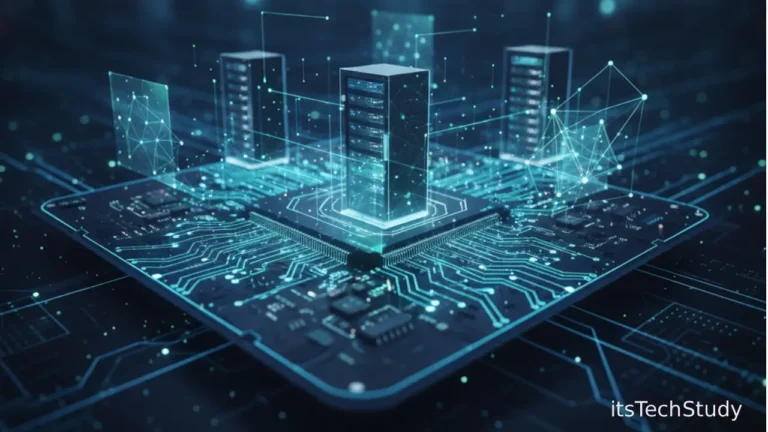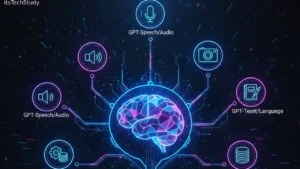Introduction: The Smartphone Revolution Continues
Remember when phones were just for calls and texts? Fast forward to 2025, and our smartphones are mini-supercomputers capable of handling everything – from 8K video editing to real-time AI image processing.
Today’s mobile phones are not just communication devices; they’re our cameras, entertainment hubs, digital purses, and even personal assistants. Behind this is an amazing web of innovation – sophisticated processors, enhanced software ecosystems, AI-optimized performance enhancements, and new connectivity protocols such as 5G and beyond.
With innovations like Xiaomi HyperOS 3 update, the state-of-the-art chipsets like DGX Spark, and the phenomenal Xiaomi 17 Pro Max flagship at the helm, mobile technology has been taken to unheard-of extremes.
So, what is it about your smartphone that makes it so powerful in 2025? Let’s take the tech beneath the screen apart and see how it all comes together.

- The Powerhouse Inside: Modern Mobile Processors
At the heart of every smartphone lies its system-on-chip (SoC) – the brain that powers everything. In 2025, we’re seeing the rise of AI-optimized chipsets, combining CPU, GPU, and neural processing units (NPUs) for lightning-fast performance and energy efficiency.
The DGX Spark Revolution
The DGX Spark chip is also one of the most discussed innovations of the year. It’s designed for speed, AI capabilities, and thermal management. With smaller nanometer architecture, it has more transistors fitted into less real estate, not only making it faster but also more energy efficient.
The most important features of DGX Spark are:
- Boosted AI processing for image recognition and predictive computing.
- Dynamic scaling of performance for gaming and multitasking.
- Extremely low latency for online experiences to be smoother.
- Enhanced thermal control to avoid overheating under heavy usage.
Comparison of Modern Smartphone Processors (2025)
| Chipset | Architecture | AI Performance | Power Efficiency | Flagship Example |
|---|---|---|---|---|
| DGX Spark | 3nm | ★★★★★ | ★★★★★ | Xiaomi 17 Pro Max |
| Snapdragon 8 Gen 4 | 4nm | ★★★★☆ | ★★★★☆ | Samsung Galaxy S25 Ultra |
| Apple A18 Bionic | 3nm | ★★★★★ | ★★★★☆ | iPhone 16 Pro |
| MediaTek Dimensity 9400 | 4nm | ★★★★☆ | ★★★★☆ | OnePlus 13 Pro |
These chips drive everything from premium gaming to AI-powered camera features, making every action feel smooth and responsive.
- Software Magic: Xiaomi HyperOS 3 and Beyond
Hardware is strong, but it’s software that makes your smartphone come alive. Xiaomi HyperOS 3 update in 2025 has been making news for its stability, performance, and design enhancements.
What’s New in Smartphones
- AI-Powered Optimization: Utilizes machine learning to anticipate user activity and assign resources dynamically.
- Unified Ecosystem: Seamlessly integrates with Xiaomi smart devices — TVs to smartwatches.
- Improved Battery Management: Adds up to 20% more screen-on time.
- Privacy Dashboard: Provides users with more control over app permissions and background usage.
- Ultra HD Display Tuning: Provides sharp visuals and adaptive brightness under any scenario.
Pro Tip: If you’re a Xiaomi 17 Pro Max owner, the HyperOS 3 update boosts your phone’s HDR performance, refresh rate control, and even AI calibration of the camera.
- Display Brilliance: The HD and Beyond Era
Smartphone screens are not merely about resolution anymore — they’re about the experience. From HD and Full HD+ to Quad HD+ and AMOLED LTPO 2.0 displays, all pixels are smarter and more power-efficient now.
Display Technologies Driving 2025 Smartphones
- Adaptive Refresh Rates (1–144Hz): Dynamically adjusts to conserve battery.
- Ultra-HD Clarity: Provides crisp visuals for gaming and content.
- Eye Comfort Modes: Suppresses blue light without color loss.
- HDR10+ and Dolby Vision Support: Adds color depth and contrast.
The Xiaomi 17 Pro Max, for instance, boasts a 6.9-inch QHD+ AMOLED LTPO 2.0 screen – capable of bringing true-to-life images even in direct sunlight.
- Camera Power: AI Meets Optics
Today’s smartphone cameras are co-designed with AI. The union of massive sensors, computational photography, and machine learning enables smartphone photography to be at par with pro cameras.
How AI is Redefining Smartphone Photography
- Scene Detection: Automatically identifies subjects and optimizes settings.
- Real-Time HDR: Interpolates multiple exposures in an instant for well-balanced shots.
- AI Portrait Enhancement: Identifies facial features and lighting for natural beauty adjustments.
- Video Stabilization through AI: Smoothes handheld footage, even in 8K.
The Xiaomi 17 Pro Max combines DGX Spark’s neural engine with its 200MP ultra-HD camera, resulting in quicker processing and amazing detail in each frame.
- Connectivity Evolution: 5G, Wi-Fi 7, and Beyond
Connectivity is yet another area driving smartphone technology ahead. With 5G(Read More) becoming a mature technology, 2025 phones are already experimenting with 5.5G and Wi-Fi 7 capabilities.
Benefits of the New Connectivity Standards
- 5G/5.5G: Downloads at lightning speed, and low-latency gaming.
- Wi-Fi 7: Supports up to 46 Gbps — ideal for 8K streaming and cloud gaming.
- eSIM and Satellite Support: Provides global connectivity even in the most remote locations.
- Bluetooth LE Audio: Enhances sound quality and decreases battery usage.
The DGX Spark modem enables all these features, offering devices such as the Xiaomi 17 Pro Max uninterrupted global coverage and lightning-fast speeds.
- Battery & Charging: Power That Keeps Up
With all these features, smartphones require smarter power solutions. Fortunately, battery tech in 2025 has finally caught up.
The Latest Innovations
- Silicon-Carbon Batteries: Provide increased density and speedier charging cycles.
- 150W Fast Charging: Charge in less than 15 minutes.
- Smart Charging AI: Adaptations user behavior to prolong long-term battery health.
Advantages and Disadvantages of Fast Charging Technology
Advantages:
- Saves time in everyday usage.
- Excellent for emergencies or business travel.
- Efficiently operates with adaptive voltage systems.
Disadvantages:
- Could minimally impact long-term battery lifespan.
- Increases heat in prolonged usage.
Nevertheless, with smart cooling and adaptive charging, contemporary smartphones handle these detriments well.
- Security and Privacy: Smarter, Safer Devices
In the age of personal data as gold, smartphone security is paramount.
New 2025 Security Innovations
- On-Device AI Threat Detection: Detects malware prior to its activation.
- Biometric Fusion: Fuses face and fingerprint scanning for super-secure access.
- Encrypted Cloud Backups: Safeguards personal data across devices.
- HyperOS Privacy Dashboard: Provides real-time permission monitoring and alerts.
Cybersecurity is not something optional anymore — it’s hard-wired into the system architecture.
- Sustainability: The Green Tech Movement
As the world rushes towards green design, smartphone makers are embracing sustainable materials and low-energy production processes.
Sustainable Features to Watch
- Recycled Aluminum Frames.
- Eco-Packaging with Minimal Plastic.
- Modular Components for Easy Repair.
- Longer Software Support to Reduce E-Waste.
Xiaomi, Apple, and Samsung have all committed carbon-neutral manufacturing targets by 2030, leading the way for the mobile industry to go green.
- The Future of Mobile Tech: What’s Next?
We’re already seeing glimpses of the future – foldable displays, AI-powered UI assistants, and neural-based computing.
Predicted Trends Beyond 2025
- AI-Generated Operating Systems that adapt in real-time to your habits.
- Quantum-based Processors for unmatched computation power.
- Fully Satellite-Connected Smartphones.
- AR-Ready Displays integrated into daily use apps.
- Holographic Projection Technology for 3D communication.
Smartphones are evolving from being tools to becoming intelligent companions — seamlessly blending hardware, software, and human behavior.
Conclusion: The Power in Your Pocket
The smartphones of 2025 are not only mighty – they’re smart ecosystems unto themselves. Thanks to breakthroughs like the DGX Spark chip, the Xiaomi HyperOS 3 update, and innovations like HD+ displays and AI-powered cameras, our smartphones are getting smarter, faster, and more human-like by the day.
The next time you open your phone, remember – it’s not only a device; it’s a work of art in modern engineering crafted to stay ahead of your digital life, sense your needs, and fuel your imagination.
The future of mobile technology isn’t arriving – it’s already in your hands.
All You Want to Know About the Latest Mobile Technology
Q1: What is Xiaomi HyperOS 3 update, and how will it enhance performance?
Ans: HyperOS 3 is Xiaomi's new operating system, designed for increased performance, improved battery life, and AI-based multitasking. It provides smoother animations, superior privacy management, and instant system response.
Q2: How is the DGX Spark chip different from other chips?
Ans: DGX Spark uses 3nm architecture, delivering superior AI computing and power efficiency. It’s optimized for gaming, camera processing, and real-time app performance, making it a next-gen mobile powerhouse.
Q3: Does HD still matter in 2025 smartphones?
Ans: Absolutely. While we’ve moved beyond standard HD, the term now symbolizes clarity and display quality benchmarks. Devices now offer QHD+, HDR10+, and adaptive refresh rates for immersive visuals.
Q4: Is fast charging safe for long-term use?
Ans: Yes, provided you are using certified chargers and letting your phone's AI power management regulate the charging cycle. The majority of new mobile phones have adaptive charging protection built-in to minimize wear and tear in the long run.
Q5: What telephone is best for general performance at present?
Ans: The Xiaomi 17 Pro Max, driven by DGX Spark and HyperOS 3, is the best in 2025 for power, design, and smart features combined.
Q6: What comes next in mobile technology?
Ans: Anticipate greater integration with AI, improved sustainability, greater AR/VR immersion, and even greater global connectivity with 6G and the introduction of quantum computing components.












No Comments Yet
Be the first to share your thoughts.
Leave a Comment